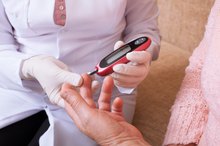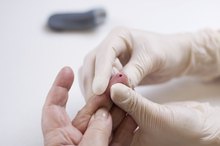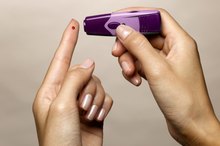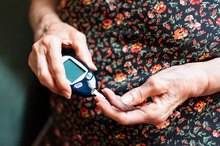What is a High Blood Sugar Level Range?
According to the American Diabetes Association (ADA), there are nearly 18 million diabetics in the United States, with nearly 25 percent of them unaware that they have the disease 1. Diabetes is a serious metabolic disorder that is caused by the pancreas not making enough insulin, or the body's resistance to it. Insulin is a hormone that helps the body assimilate blood glucose to produce energy. When there is a problem metabolizing blood glucose, its concentrations rise in the blood—a condition called hyperglycemia or high blood sugar.
The Ups and Downs of Blood Sugar
Everyone experiences moderate fluctuations in their blood sugar levels. **The normal blood glucose range in healthy individuals is between 70 and 125 mg/dl.
** During times of prolonged physical activity, the glucose level can dip below 50 mg/dl. After carbohydrate-rich meals, it can soar to over 180. That's normal, according to Dr. Edward Horton of the Joslin Diabetes Center. However, when blood sugar levels remain low or high, symptoms start to appear.
- Everyone experiences moderate fluctuations in their blood sugar levels.
- During times of prolonged physical activity, the glucose level can dip below 50 mg/dl.
Causes of High Blood Sugar
Normal Blood Sugar Range in Adults
Learn More
The most common cause of high blood sugar is diabetes. There are two types—Type I and Type II. Type I diabetes is called insulin dependent because there is not enough natural insulin produced by the pancreas, so the diabetic is dependent on insulin injections. Type I diabetics often get the disease very early in life, hence its alternate name of juvenile diabetes. **Type II is called insulin independent (also called adult onset diabetes) because the body may not produce enough insulin, or body tissues may be resistant to insulin and so it is perceived as a shortage, according to the Mayo Clinic.
** Type II diabetes is called adult onset diabetes because it typically affects adults later in life. It accounts for over 90 percent of diabetics, according to the National Institute of Diabetes and Digestive and Kidney Diseases (NIDDK).
- The most common cause of high blood sugar is diabetes.
- Type II is called insulin independent (also called adult onset diabetes) because the body may not produce enough insulin, or body tissues may be resistant to insulin and so it is perceived as a shortage, according to the Mayo Clinic.
The Long Term Effects of Hyperglycemia
Regardless of which type of diabetes one has, the results are the same. Inside the body, high concentrations of blood sugar can begin damaging sensitive tissues and organs and can ultimately cause a complete failure of systems, according to NIDDK.
Diagnosing High Blood Sugar
What Are the Blood Sugar Levels for Diabetes?
Learn More
The easiest way to detect high blood sugar is by having your blood drawn as part of your annual physical examination. Part of what they're measuring is your fasting blood glucose level. It's important that the test be done while fasting, the American Diabetes Association says, because it's a good indicator of your normal level of glucose without the influence of exercise or food 1. The normal range for fasting blood glucose is 70 to 125 mg/dl. If your values are higher than 130 mg/dl, your doctor may ask you to repeat the test in a week. **If your results are high during the second test, an oral glucose tolerance test (OGTT) will likely be ordered.
During an OGTT, the patient is asked to drink a high concentration of glucose in liquid. Blood samples are drawn in the beginning and at 2-hour intervals throughout the day to determine how well the body processes glucose. If the glucose concentrations remain high, you may have diabetes. Another way to test for hyperglycemia is to measure your hemoglobin A1c (HbA1c). Blood glucose competes with oxygen by attaching itself to the hemoglobin in the red blood cells, according to the Mayo Clinic. High concentrations of HbA1c can interfere with the way that cells get oxygen from the blood.
While standard blood glucose tests measure the amount of glucose in your blood at that time, HbA1c represents the average amount of glucose in your blood over the entire lifespan of your red blood cells—about 120 days. ** Normal HbA1c concentrations should be less than 7 percent of your total hemoglobin, the Mayo Clinic Advises.
- The easiest way to detect high blood sugar is by having your blood drawn as part of your annual physical examination.
- While standard blood glucose tests measure the amount of glucose in your blood at that time, HbA1c represents the average amount of glucose in your blood over the entire lifespan of your red blood cells—about 120 days.
Dealing with High Blood Sugar
If you suspect that you have high blood sugar, visit your doctor right away. You may have had hyperglycemia or diabetes for a long time—maybe years. As a result, it likely has already caused significant damage to your body, the ADA warns. The good news is that there are a number of effective ways to treat high blood sugar, including medication, diet and insulin injections. They include changes in your diet, exercise and medications.
- If you suspect that you have high blood sugar, visit your doctor right away.
- You may have had hyperglycemia or diabetes for a long time—maybe years.
Related Articles
References
- American Diabetes Association
- National Institute of Diabetes and Digestive and Kidney Diseases. Diabetes diet, eating, & physical activity. Published December 2016.
- American Diabetes Association. The big picture: Checking your blood glucose.
- American Diabetes Association. 6. Glycemic Targets: Standards of Medical Care in Diabetes-2020. Diabetes Care. 2020;43(Suppl 1):S66-S76. doi:10.2337/dc20-S006
- American Diabetes Association. 14. Management of diabetes in pregnancy: Standards of medical care in diabetes-2020. Diabetes Care. 2020;43(Suppl 1):S183-S192. doi:10.2337/dc20-S014
- Porcellati F, Lucidi P, Bolli GB, Fanelli CG. Thirty years of research on the dawn phenomenon: Lessons to optimize blood glucose control in diabetes. Diabetes Care. 2013;36(12):3860-2. doi:10.2337/dc13-2088
- American Diabetes Association. 5. Lifestyle management: Standards of medical care in diabetes-2019. Diabetes Care. 2019;42(Suppl 1):S46-60. doi:10.2337/dc19-S005
- Colberg SR, Sigal RJ, Yardley JE, et al. Physical activity/exercise and diabetes: A position statement of the American diabetes association. Diabetes Care. 2016;39(11):2065-2079. doi:10.2337/dc16-1728
- American Diabetes Association (ADA). Understanding A1C.
- Garber AJ, Abrahamson MJ, Barzilay JI, et al. Consensus statement by the American association of clinical endocrinologists and American college of endocrinology on the comprehensive type 2 diabetes management algorithm - 2019 executive summary. Endocr Pract. 2019;25(1):69-100. doi:10.4158/CS-2018-0535
Writer Bio
Allen Smith is an award-winning freelance writer living in Vail, Colo. He writes about health, fitness and outdoor sports. Smith has a master's degree in exercise physiology and an exercise specialist certification with the American College of Sports Medicine at San Diego State University.









